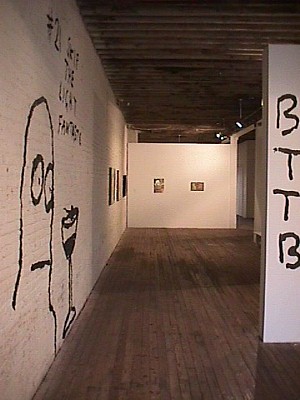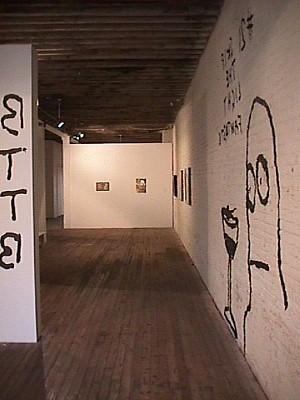| |
 
2000.11.11
| |
2000.11.11
more vehicles than roads
What I like about these movies is how vehicles are both very literal and very symbolic, and, moreover, it is the seamless transition from literalness to symbolism that the vehicles deliver.
2002.11.11 07:26
Re: Banker to offer art work for auction
All this has given me a great idea, that is, to make the IRS the heir of all my artworks when I dead.
2002.11.11 20:20
Re: Bear Necessities: The Art of Rachel Harrison
What I find inspiring about Rachel Harrison's art work (at least what is pictured in Artforum November 2002) is that I can now look at my entire house as a museum containing/exhibiting numerous paintings, sculptures, photographs and installations.
[joke]
What comes after house/palace?
Museum.
What comes after museum?
Pre-shrine.
| |
2002.11.11 14:09
positioning Étant Donnés [wavelengths]
[from Jennifer Gough-Cooper's chronology (Ephemerides) within Marcel Duchamp: Work and Life (1993) with notes/questions by myself]:
6 May 1949. Philadelphia ...and Duchamp makes detailed notes on the architecture of the different rooms [of the Philadelphia Museum of Art where the Arensberg Collection ultimately ends up].
I wonder if these detailed notes still exist somewhere, and whether they might offer an indication that Duchamp in 1949 at least knew of the space in the PMA where Étant Donnés is ultimately housed.
20 March 1961. Philadelphia In the evening, with Katherine Kuh as moderator, Duchamp, the sculptor Louise Nevelson, and two painters, Larry Day and Theodoror Stamos, are members of a panel to discuss "Where do we go from Here?" at the Philadelphia Museum College of Art.
Of the panelists, Duchamp is the only one to make a prepared statement. [The 20 paragraph statement is published in full within the chronology and ends with, "The great artist of tomorrow will go underground."
Roger LaPelle, in Tout Fait's Notes issue 1, no. 3, writes of Duchamp's visit/lecture at the Pennsylvania Academy of Fine Arts in 1962 where Duchamp refers to himself as an "underground artist."
[I was in Philadelphia on 20 March 1961, but I was not listening to Duchamp downtown, rather, I was at home celebrating my 5th birthday (no kidding), and I distinctly remember thinking at the time, "where do I go from here? (just kidding)]
Has the above mentioned text been published anywhere else beside the Gough-Cooper chronology? It is a very provocative/prescient late Duchamp text.
31 March 1968. New York [the entry ends with] However, the question of the ultimate presentation of Etant donnes preoccupied Marcel. He finally decided that the one person who might help him solve this problem was Bill Copley. When Marcel first told him the story of the piece Bill could not wait to see it, and readily accepted to present the "demountable approximation" in the name of the Cassandra Foundation to the Philadelphia Museum of Art, if the trustees would accept it.
What I am interested in is whether Duchamp's involvement in the installation of the Arensberg Collection (roughly 1949 to 1954) at the Philadelphia Museum of Art has any direct bearing on the on-going creation and ultimate position/presentation of Étant Donnés. I'll pursue all this (I hope) at the PMA library, but if there is already a published study of Duchamp's role vis-à-vis the PMA installation of the Arensberg collection I would much appreciate being made aware of it.
|